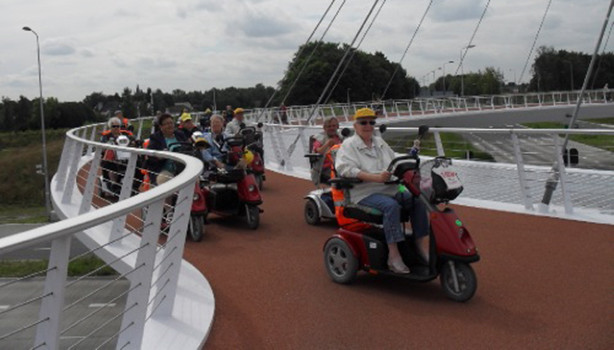Every so often, videos captured on Dutch cycle paths feature individuals using mobility scooters. For many in the Netherlands, this is a common sight, not at all unusual. People with disabilities are legally permitted to operate a range of vehicles, from mobility scooters to hand-operated tricycles, on these dedicated paths. This infrastructure provides a safe and independent means of transportation, liberating them from reliance on others for assistance. In essence, the extensive Dutch cycle path network significantly enhances the travel freedom for people with disabilities.
The regulations governing ‘Invalid Carriages,’ a somewhat outdated term, vary considerably across Europe. A stark contrast exists between the UK and the Netherlands. In the UK, mobility scooters are restricted to a maximum speed of 8mph (12.9km/h) on roads. This slow pace can deter users from venturing onto roads shared with much faster, heavier motorized traffic, given their vulnerability. Conversely, in the Netherlands, motorized mobility scooters enjoy greater flexibility. They are legally allowed to reach speeds of up to 45km/h (28mph) on roads, only slightly slower than standard motorized traffic (50km/h or 31mph). Furthermore, they can utilize the vast network of cycle paths. Within built-up areas on these paths, they are permitted to travel at 30km/h (18mph), which is notably faster than the average Dutch cyclist. However, in practice, most mobility scooter users on cycle paths maintain a speed closer to that of typical Dutch cyclists, around 20km/h (12.4mph), allowing for seamless integration.
 scooter club eindhoven
scooter club eindhoven
Mobility scooters and other vehicles designed for people with disabilities are a common and accepted sight on Dutch cycling infrastructure.
The accessibility of well-designed Dutch cycling infrastructure for mobility scooters offers individuals who are unable to cycle independently a crucial means of transport. This access profoundly improves their quality of life. Personal experience underscores this point. When my father experienced balance issues following a series of minor strokes, losing his ability to cycle, he transitioned to a mobility scooter. This allowed him to maintain his independence and continue activities such as his volunteer work at Utrecht Cathedral, where he greeted tourists and performed light administrative tasks. The mobility scooter enabled him to undertake various short journeys independently for nearly a decade, until his health condition made navigating traffic environments too challenging. These were ten valuable years during which he continued to contribute to society, which is vital for personal well-being and societal benefit as a whole. In the Netherlands, national healthcare often provides mobility scooters, and sometimes local municipalities cover the costs or offer long-term rentals. These scooters are primarily intended for individuals who retain the ability to walk short distances; they may need to be returned if no longer in use.
Dutch law classifies mobility scooters similarly to mopeds or scooters. However, public perception differs significantly. While there is widespread and justified complaint about speeding scooters on cycle paths, complaints about mobility scooters are rare. This likely stems from the fact that many Dutch people have a close relative or acquaintance who relies on a mobility scooter. Understanding the importance of these devices for individuals fosters a sense of shared space and acceptance on cycle paths for mobility scooter users and other specialized vehicles.
The everyday integration of mobility scooters into Dutch cycling culture is so commonplace that it even features in advertising, as illustrated in this video. The video encourages people to become a Maatje (buddy) to someone who benefits from such mobility aids.
Members of the “Scooter club Eindhoven” put the Eindhoven Hovenring to the test. Numerous clubs exist throughout the Netherlands for mobility scooter users. They organize group outings, and when the Eindhoven Hovenring was constructed, the local ‘Scootmobiel vereniging‘ was consulted to assess the gradient of the ramps.
In conclusion, well-designed cycling infrastructure benefits not only cyclists of all ages but also pedestrians by separating them from motorized traffic. Critically, it significantly enhances the quality of life for people with disabilities. Dutch cycle paths, therefore, are demonstrably beneficial for society as a whole.
Regulations for Mobility Scooters in the Netherlands
For motorized vehicles designed for people with disabilities, including electric wheelchairs, mobility scooters, and covered vehicles, the following regulations apply within the Netherlands:
Legally, a mobility scooter operator is considered a pedestrian when using pavements (sidewalks). When using cycle paths or roadways (motorways are prohibited), they are classified as slow-speed mopeds/scooters.
- Insurance: Third-party liability insurance is mandatory. Proof of insurance must be visibly displayed on the vehicle.
- Age Restriction: Operators must be 16 years of age or older.
- Size Limits: Vehicles must not exceed the following dimensions:
- Width: 1.10 meters (3 ft 7 in)
- Height: 2 meters (6 ft 7 in)
- Length: 3.50 meters (11 ft 6 in)
- Speed Limits:
- Roadways: 45km/h (28mph)
- Cycle paths: 30 km/h (18mph) in urban areas, 40km/h (25mph) in rural areas
- Pavements (sidewalks): 6km/h (3.7mph, to ensure pedestrian safety)
(Note: Speed should always be adjusted to match the general speed of other road users in any given location.)
(Legal information source: Regionaal orgaan verkeersveiligheid Limburg)
